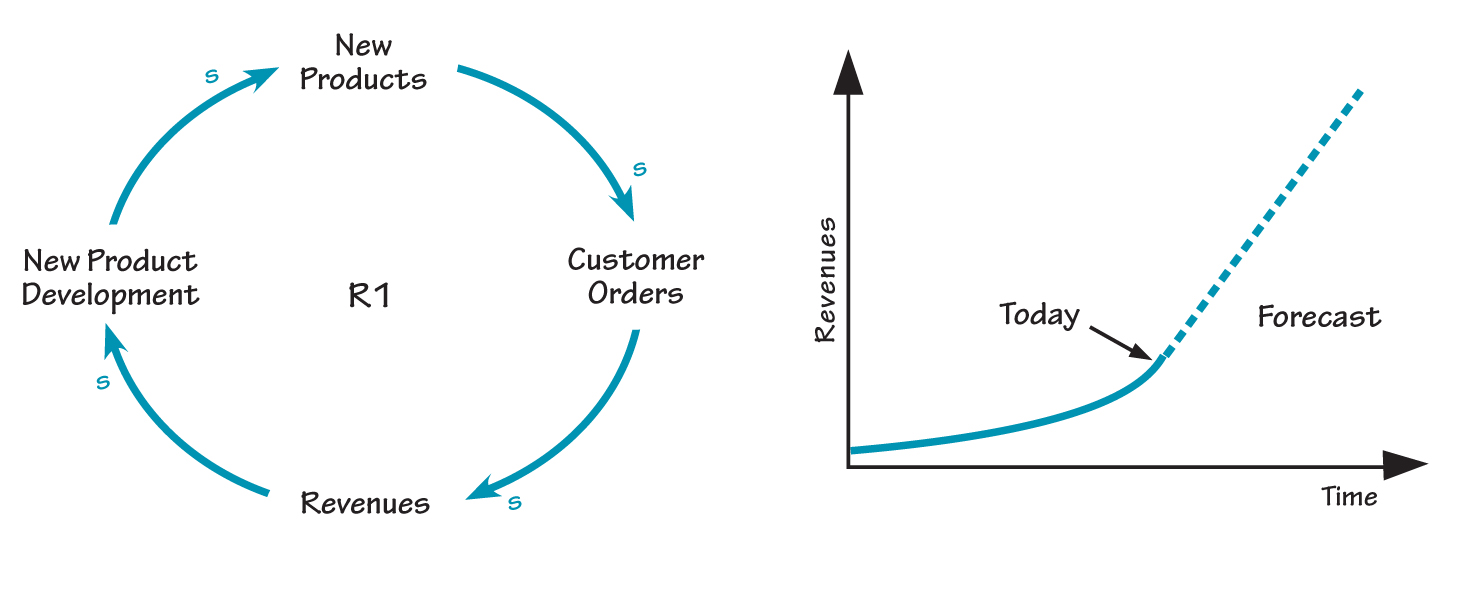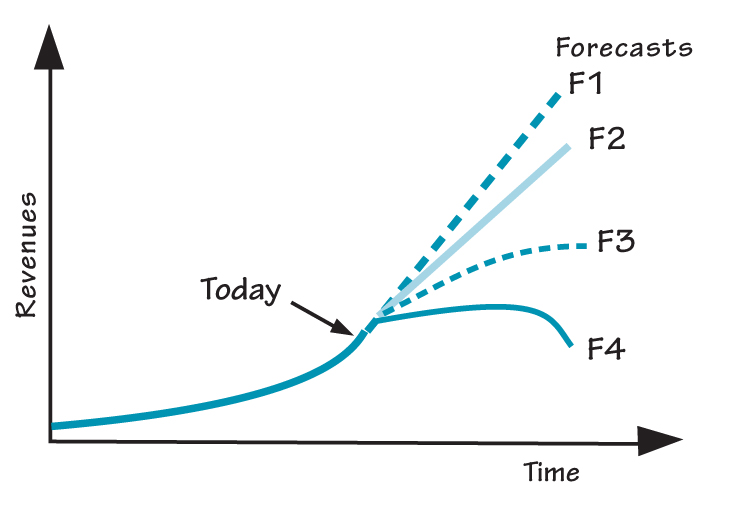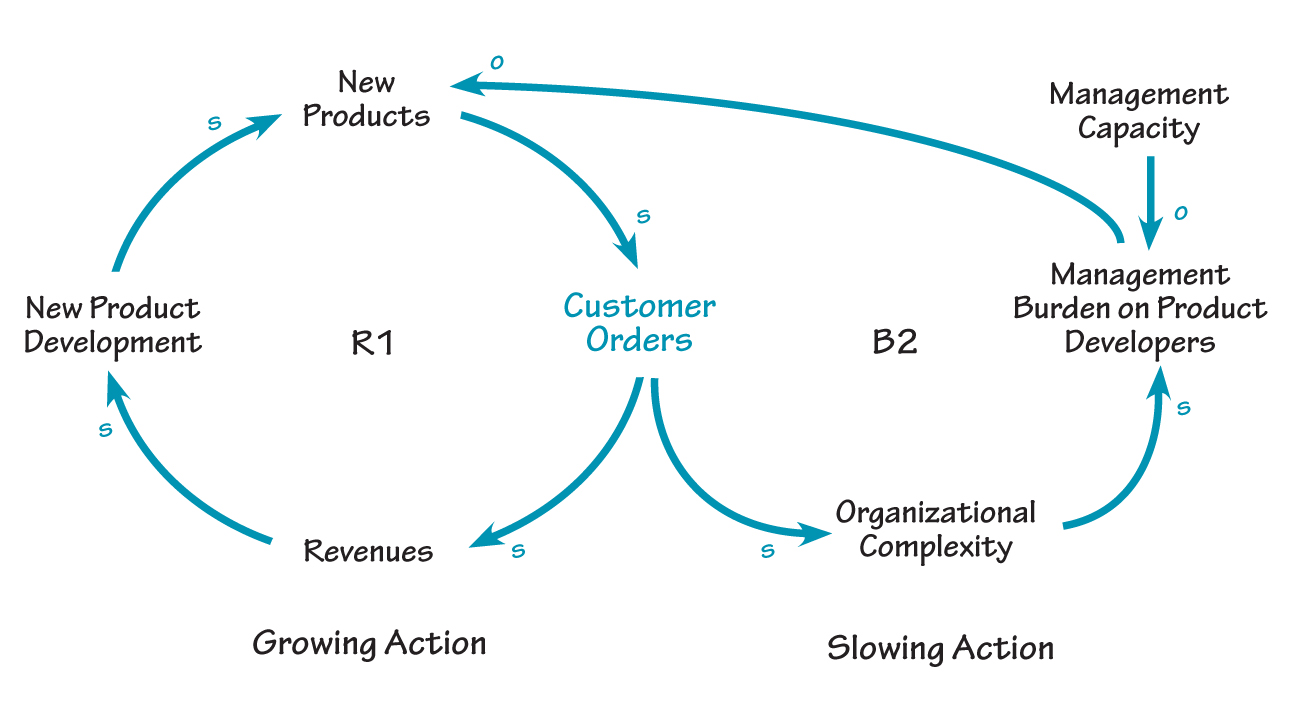The adage “a bird in the hand is worth two in the bush” captures an old belief that something “known” is more valuable than something less certain. Taking that one step further, we might say that present circumstances are somehow more “real” than future possibilities. But such statements confuse uncertainty with ignorance of the structures that produce future outcomes, leading us to assume that everything in the future is inherently uncertain.
The better we understand the structure of a system, the better we can predict the future behavior of that system.
Another deep-rooted assumption is that past behavior is a good predictor of future behavior—hence our never-ending attempts to forecast, anticipate, and otherwise guess at future outcomes by looking at historical data. Without a deeper understanding of the underlying structures that produce the observed behaviors, forecasts fail when we need them the most—when the future deviates from the past.
Inaccurate forecasts stem from two causes: either we do not understand the mechanisms governing the actions we are trying to predict, or the situations themselves are inherently unpredictable. In the latter case, there isn’t much we can do other than take our best shot with whatever methods seem to produce the best results. But before we throw up our hands in despair, we should be careful to differentiate between true uncertainty and predetermined elements—those things we can predict if we have an adequate understanding of the underlying structure.
Scenario Planning
Planners at Royal Dutch Shell recognized the importance of distinguishing between true uncertainty and predetermined elements as part of the scenario planning process. They defined a predetermined element as an event that has already occurred—or most certainly will occur—but the consequences of which have not yet materialized. For example, if there is an auto accident on a major highway at rush hour, we can predict that traffic jams within the city and ripple effects on secondary roads will be the predetermined outcomes of that event. The structure of the system— number of lanes, alternative routes, speed limits, rush hour traffic volume, population density— makes the outcome very predictable. Identifying such predetermined elements is fundamental to the planning process, because it allows us to predict future outcomes based on the structure of the current situation.
Structure-Behavior Link
The better we understand the structure of a system, the better we can predict the future behavior of that system. This is one of the most important principles of systems thinking—structure, to a large extent, determines behavior. Although there may be uncertainty about the exact timing and duration of the outcome, the nature and eventuality of it is clear. Knowing this, we can greatly improve our ability to influence the behavior of a system.
Together, systems archetypes and Behavior Over Time diagrams (BOTs) can help us identify predetermined outcomes of a particular situation. Systems archetypes can help us see the structures within a complex system, while Behavior Over Time diagrams offer a glimpse into the expected behavior of that structure over time.
Identifying Predetermined Elements
REINFORCING GROWTH WITH NEW PRODUCTS

A reinforcing dynamic of new products increasing revenue, which is then invested in additional new products (R1), will initially produce a growth curve.
For example, in many companies, new product development is the main engine of growth (see “Reinforcing Growth with New Products”). As new products are released, customer orders and revenues increase, which provides more funds to pump back into new product development (R1). In this situation, our sales data would show that we are on a healthy growth curve, and most forecasts would predict more of the same. If we look at the situation from a “Limits to Success” perspective, however, we can go beyond straight line projections by better understanding the structural forces at play. In reality, there are many different possible outcomes that can never be predicted by historical data alone (see “Multiple Futures”). Revenues could grow at a slower rate (F2), plateau (F3), or collapse (F4). Given these possibilities, what kind of prediction can we make for future outcomes? The answer is determined not by looking at past data, but by looking at the underlying structure.
MULTIPLE FUTURES

There are many possible outcomes for revenues, given our current reinforcing structure of increasing product offerings: forecasted growth (F1), continued growth at a slower rate (F2), plateau (F3), or decline (F4).
When we understand the structural landscape, we can better distinguish between uncertainty and predetermined elements. In a “Limits to Success” structure, we would look for balancing loops that the growth in revenues might trigger (see “Identifying Predetermined Consequences of Limits”).
For example as customer orders grow, the organizational infrastructures needed to service them also grows. As more people are hired, the organizational complexity increases and places an additional managerial burden on those responsible for developing products. If the company’s way of managing its product development effort does not change with the changing needs (which is often the case in a fast-growth environment), a decline in new products is a predetermined consequence of the “Limits to Success” structure. The more the company tries to push harder on the growing action, the stronger the slowing action will become, as long as the structure of the management capacity limit remains unchanged.
From Historical Behavior to Archetype
Behavioral charts can also provide a starting point for selecting an appropriate archetype to use, since each archetype is associated with a particular dominant behavior mode that is characteristic of its structure. For example, imagine you are a marketing manager in charge of a new product launch. You have been running a series of campaigns over the past year, and sales have grown steadily. Last quarter, however, you noticed that the growth in sales was beginning to decline. This quarter you increased your marketing efforts, but it seemed to have little impact.
IDENTIFYING PREDETERMINED CONSEQUENCES OF LIMITS

The “Limits to Success” structure suggests that there are potential balancing processes that could limit future growth. For example, as the organizational infrastructure grows to service the increasing orders, product developers might have less time to devote to creating new products (B2). The result may be a decline in products and a consequent decline in orders (R1)
The historical pattern of behavior can offer clues that help identify possible archetypal structures, which then allows us to predict future behavior given the system structure. It is an iterative process. For example, the historical data of sales growing and then plateauing suggests a “Limits to Success” archetype may be at work. Having identified a “Limits to Success” structure, we can use BOT diagrams to flesh out the particular limits affecting our sales growth. How does the volume of campaigns seem to affect sales over time? Are there pressures building in the organization as a result of the growth? What does the production capacity look like over time? Is the size of the market growing or stagnating? Charting these factors over time can offer insight into the particular balancing processes that need to be addressed in order to eliminate potential limits to growth before they affect future sales.
Or suppose you are a new plant manager of a processed food company and you notice that a oncepopular product has been declining steadily in sales. When you ask other employees for their picture of the situation, they tell you that consumer tastes have changed and the product does not have as much appeal as it used to. The declining sales coupled with a declining level of investment into the product itself, however, makes you wonder if something else is going on. This behavior over time suggests that a “Drifting Goals” archetype may be at work.
Creating (Not Forecasting) Your Future
This link between structure and behavior is critical in our systems thinking worldview. Linking each archetype with a specific set of behavior patterns can help us see into the future with a different set of eyes. We can then see more clearly the difference between true uncertainty and predetermined events that have yet to unfold. By identifying and working on the underlying structures that produce the behaviors, we can better predict the future by helping to create it instead of just trying to forecast it.
Daniel H. Kim is co-founder of Pegasus Communications, founding publisher of The Systems Thinker newsletter, and a consultant, facilitator, teacher, and public speaker committed to helping problem-solving organizations transform into learning organizations.
